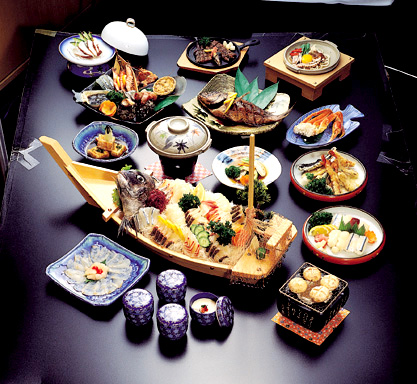Cuisine
Japanese cuisine has developed over the centuries as a result of many political and social changes. The cuisine eventually changed with the advent of the medieval age which ushered in a shedding of elitism with the age of shogun rule. In the early modern era massive changes took place that introduced non-Japanese cultures, most notably Western culture, to Japan.
The modern term "Japanese cuisine" (nihon ryōri or washoku) means traditional-style Japanese food, similar to that already existing before the end of national seclusion in 1868. In a broader sense of the word, it could also include foods whose ingredients or cooking methods were subsequently introduced from abroad, but which have been developed by Japanese who made them their own. Japanese cuisine is known for its emphasis on seasonality of food (shun), quality of ingredients and presentation.
Some of the well-known terms are sushi, sashimi, tempura, teppan yaki etc.
Putting questions of taste aside for a moment, it is impossible to deny that Japanese cuisine is almost universally regarded as the most beautiful in the world. The careful arrangement of the food has to do with the great concern that Japanese have for design and order. With the serving of food, nothing is left to chance. Food is served in individual lacquer or china dishes that are chosen for their shape and colour to suit the food that goes into them. The desired combination of colours and textures is also a factor in choosing the food itself.
Sports
Sport in Japan is a significant part of Japanese culture. Both traditional sports such as sumo and martial arts, and Western imports like baseball and association football, are popular with both participants and spectators.
Sumo is considered Japan's national sport, and is deeply rooted in Japanese religion and culture. The most popular spectator sport is baseball, which was introduced to the country by visiting Americans in the 19th century. The Nippon Professional Baseball league is Japan's largest professional sports league. Martial arts such as judo, karate and modern kendō are also widely practiced and enjoyed by spectators in the country.
Association football has gained wide popularity since the founding of the Japan Professional Football League in 1992. Other popular sports include figure skating, golf and racing, especially auto racing.
Popular Culture
Japanese popular culture not only reflects the attitudes and concerns of the present but also provides a link to the past. Popular films, television programs, manga, and music all developed from older artistic and literary traditions, and many of their themes and styles of presentation can be traced to traditional art forms. Contemporary forms of popular culture, much like the traditional forms, provide not only entertainment but also an escape for the contemporary Japanese from the problems of an industrial world.
When asked how they spent their leisure time, 80 percent of a sample of men and women surveyed by the government in 1986 said they averaged about two and a half hours per weekday watching television, listening to the radio, and reading newspapers or magazines. Some 16 percent spent an average of two and a quarter hours a day engaged in hobbies or amusements. Others spent leisure time participating in sports, socializing, and personal study. Teenagers and retired people reported more time spent on all of these activities than did other groups.
Many anime and manga are becoming very popular around the world, as well as Japanese video games, music, fashion, and game shows[7]; this has made Japan an "entertainment superpower" along with the United States and United Kingdom.
In the late 1980s, the family was the focus of leisure activities, such as excursions to parks or shopping districts. Although Japan is often thought of as a hard-working society with little time for leisure, the Japanese seek entertainment wherever they can. It is common to see Japanese commuters riding the train to work, enjoying their favourite manga, or listening through earphones to the latest in popular music on portable music players.
A wide variety of types of popular entertainment are available. There is a large selection of music, films, and the products of a huge comic book industry, among other forms of entertainment, from which to choose. Game centres, bowling alleys, and karaoke are popular hangout places for teens while older people may play shogi or go in specialized parlours.
Together, the publishing, film/video, music/audio, and game industries in Japan make up the growing Japanese content industry, which, in 2006, was estimated to be worth close to 26 trillion Yen (USD$ 400 billion).
Sources :
http://en.wikipedia.org/wiki/Culture_of_Japan#National_character
http://www.japanfocus.org/data/j.cuisineart.jpg
http://www.oakhotel.co.jp/english/JapanSumoMatch.jpg
http://s2.hubimg.com/u/342485_f520.jpg



No comments:
Post a Comment